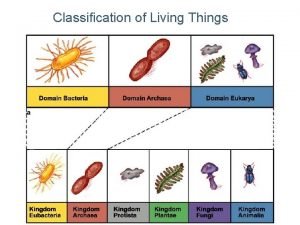Classification of Living Things TEK 8 A Define








- Slides: 8

Classification of Living Things TEK 8 A: • Define taxonomy and recognize the importance of a standardized taxonomic system to the scientific community. TEK 8 B: • Categorize organisms using a hierarchical classification system based on similarities and differences shared among groups. TEK 8 C: • Compare characteristics of taxonomic groups, including archaea, bacteria, protists, fungi, plants and animals.

Finding Order in Diversity • Biologists use a classification system to name organisms and group them in a logical manner. • Taxonomy is the branch of biology that groups and names organisms based on their common characteristics. Tacitus bellus • All scientists throughout the world will be using the same name! • Classification systems change with expanding knowledge. Benefits of Taxonomy All scientists are using the same name. Organisms are organized based on common characteristics. Populus tremuloides Quaking Aspen A standardized name clarifies discrepancies when different common names are used around the world.

Taxons and Binomial Nomenclature Linnaeus’s hierarchical system of classification includes eight levels (from largest to smallest) Ex. Grizzly Bear (common name) • • Domain Eukarya Kingdom Animalia Phylum Chordata Class Mammalia Order Carnivora Family Ursidae Genus Ursus Species arctos Binomial nomenclature uses the two most specific levels of classification as the scientific name: (unique name) Genus species Each organism is referred to by it’s two-part name: Ex. Grizzly bear is: Ursus arctos (scientific name) Each of the levels is called a TAXON

DK System of Classification P C O F G S • Taxonomic categories, an acronym: • Domain Dear • Kingdom King • Phylum Phillip • Class Came • Order Over • Family For • Genus Good • Species Soup Domain Kingdom Phylum Class Order Family Genus Species • The most closely-related organisms will be in the same species • The more specific you go down the classification system, the more characteristics the organisms will have in common. • ** If two organisms belong to the same Family, they also belong to the same Order, Phylum, Kingdom and Domain! • **Two organisms cannot be the same species if they are not the same in all other classifications!

Domains: Most inclusive (broadest) category There are 3: Eukarya – includes Kingdoms: Protista, Fungi, Plants & Animals Bacteria – Kingdom Eubacteria Archaea – Kingdom Archaebacteria Organisms are placed into Kingdom categories by: • Cell type • Nutrient acquisition • Reproduction

Taxonomic Diagrams Cladogram Which organism is the outgroup Hagfish Which 2 organism are more closely related Mouse and Chimp Attempt to trace the process of evolution by focusing on shared features

Dichotomous Keys Identify Organisms • Dichotomous keys contain pairs of contrasting descriptions. • After each description, the key directs the user to another pair of descriptions or identifies the organism. Example: 1. a) Is the leaf simple? Go to 2 b) Is the leaf compound? Go to 3 2. a) Are margins of the leaf jagged? Go to 4 b) Are margins of the leaf smooth? Go to 5

QR Quiz https: //forms. office. com/Pages/Response. Page. aspx? id=I 5 v. Qr 0 Sinky_Ove. Sf. D 0 Rniq O 1 o 4 N 6 Jh. Go 0 UZld. GCts. ZUNUZGT 05 WUj. VGR 09 DVzh. PWjk 2 MDRRV 0 w 3 MC 4 u















